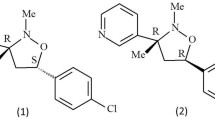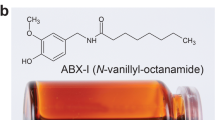Abstract
Trichome exudate compounds isolated from leaves ofNicotiana tabacum, N. glutinosa (accessions 24 and 24a), and 21 otherNicotiana species were evaluated for biorational activity againstC. lagenarium, the anthracnose pathogen of cucumber. Exudate compounds tested were the cembrane diterpenes α- and β-4,8,13-duvatriene-1,3-diols (DVT diols); the labdane diterpenes (13-E)-labda-13-ene-8α,15-diol (labdenediol) and (13-R)-labda-14-ene-8α, 13-diol (sclareol); extracts fromN. gossei; and various sugar ester isolates. In dose-response experiments test compounds were applied to a water agar surface that was then inoculated with a conidial suspension. Low levels of most test compounds reduced or completely inhibited germination ofC. lagenarium conidia. IC50 values, concentrations (micrograms per square centimeter) at which conidium germination was reduced 50%, were 6.3 for DVT diols, 19.3 for sclareol, 1.0 for labdenediol, 2.8 for a mixture of sclareol and labdenediol, 1.2 for anN. gossei sucrose ester and 4.1 for theN. gossei crude extract. Higher levels of DVT diols and the sclareol-labdenediol mixture were required to reduce lesion size and number on inoculated cucumber leaves. At the highest concentration tested, 100 µg/cm2, the DVT diols and sclareol-labdenediol mixtures protected cucumbers against lesion development by 93 and 98%, respectively. Sugar ester mixtures from 20Nicotiana species and three different sugar ester fractions fromN. bideglovii had in vitro antifungal activity at a concentration of 48 µg/cm2. Sugar esters from nine of the species includingN. acuminata, N. attenuata, N. clevelandii, N. maritima, N. miersii, N. noctiflora, N. occidentalis, N. rustica, and fractions 10, 12, and 13 fromN. bideglovii completely inhibitedC. lagenarium conidium from germinating. Sugar ester mixtures from only four species,N. plumbaginifolia, N. bonariensis, N. simulans, andN. palmerii, had no significant effect onC. lagenarium conidium germination. These results suggest the potential ofNicotiana exudates as biorationals in reducing disease development.
Similar content being viewed by others
References
Gentile, A.G., andStoner, A.K. 1968. Resistance inLycopersicon species to the tobacco flea beetle.J. Econ. Entomol. 61:1347–1349.
Gibson, R.W. 1971. Glandular hairs providing resistance to aphids in certain wild potato species.Ann. Appl. Biol. 68:113–119.
Goode, M.J. 1958. Physiological specialization inColletotrichum lagenarium.Phytopathology 48:79–83.
Jackson, D.M., Severson, F.R., Johnson, A.W., andHerzog, G.A. 1986. Effects of cuticular duvane diterpenes from green tobacco leaves on tobacco budworm (Lepidoptera: Nocutuidae) oviposition.J. Chem. Ecol. 12:1349–1359.
Kennedy, B.S., Nielsen, M.T., Severson, R.F., Sisson, V.A., Stephenson, M.K., andJackson, D.M. 1992. Leaf surface chemicals fromNicotiana affecting germination ofPeronospora tabacina (Adam) sporangia.J. Chem. Ecol. 18:1467–1479.
Kuć, J., Shockley, G., andKearney, K. 1975. Protection of cucumber againstColletotrichum lagenarium byColletotrichum lagenarium.Physiol. Plant Pathol. 7:195–199.
Menetrez, M.L., Spurr, H.W., Jr., Danehower, D.A., andLawson, D.R. 1990. Influence of tobacco leaf surface chemicals on germination ofPeronospora tabacina Adam sporangia.J. Chem. Ecol. 16:1565–1576.
Nielsen, M.T., andSeverson, R.F. 1990. Variation of flavor components on leaf surfaces of tobacco genotypes differing in trichome density.J. Agric. Food Chem. 38:467–471.
SAS Institute Inc. 1985. SAS User's Guide: Statistics, Version 5 ed. SAS Institute Inc., Cary, North Carolina. 956 pp.
Severson, R.F., Arrendale, R.F., Chortyk, O.T., Johnson, A.W., Jackson, D.M., Gwynn, G.R., Chaplin, J.F., andStephenson, M.G. 1984. Quantitation of cuticular components of green tobacco leaf.J. Agric. Food Chem. 32:566–570.
Severson, R.F., Johnson, A.W., andJackson, D.M. 1985. Cuticular constituents of tobacco: Factors affecting their production and their role in insect and disease resistance and smoke quality.Rec. Adv. Tob. Sci. 11:105–174.
Severson, R.F., Stephenson, M.G., Johnson, A.W., Jackson, D.M., andChortyk, O.T. 1988. Isolation and preparative chromatography of the major cuticular diterpenes of green tobacco.Tob. Sci. 32:99–103.
Severson, R.F., Jackson, D.M., Johnson, A.W., Sisson, V.A., andStephenson, M.G. 1991. Ovipositional behavior of tobacco budworm and tobacco hornworm, pp. 264–277,in P.A. Hedin (ed.). Naturally Occurring Pest Bioregulators. American Chemical Society Symposium Series No. 449, Washington, D.C.
Author information
Authors and Affiliations
Rights and permissions
About this article
Cite this article
Kennedy, B.S., Nielsen, M.T. & Severson, R.F. Biorationals fromNicotiana protect cucumbers againstColletotrichum lagenarium (Pass.) ell. & halst disease development. J Chem Ecol 21, 221–231 (1995). https://doi.org/10.1007/BF02036653
Received:
Accepted:
Issue Date:
DOI: https://doi.org/10.1007/BF02036653




